S︎LARBLOCK is a speculative architecture project based in Vienna aiming to transform existing public housing blocks into solar architectures. The add-on is a wooden skeleton structure, creating an affordable wintergarden extension of the current living areas, providing views, light, heat gains in winter as well as ventilation and shading in summer.








